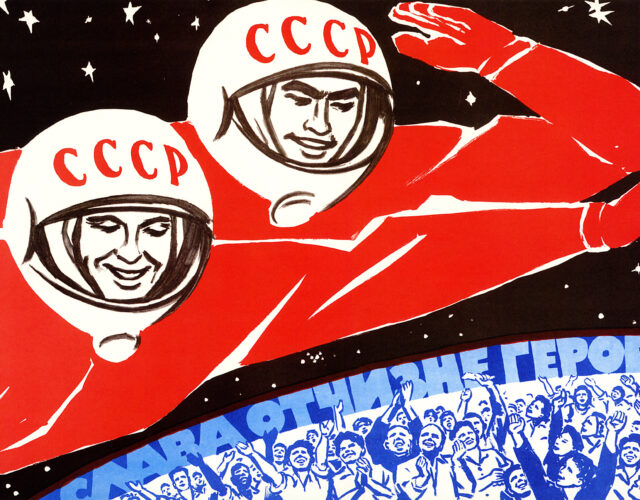On October 4, 1957, the Soviet Union shot a metal sphere the size of a beach ball into orbit around Earth. This landmark in space exploration provoked a slew of conflicting emotions in American scientists, politicians, and the broader public.
On the one hand, a sense of wonder was natural. The Russian craft, Sputnik 1, was the world’s first artificial satellite. It proved that humans, or at least their creations, could reach space. And it inspired a generation of students to pursue science.
On the other hand, the Soviet success panicked U.S. leaders locked in an ideological cold war with their Communist rivals. Allowing the Soviets to win the space race would legitimize the Communist experiment and devalue democracy. Military strategists also worried: the success of the Sputnik program demonstrated the Soviet Union’s potential to launch missiles around the planet. To many Americans, Sputnik 1 represented a dark future where the Soviet Union reigned as the world’s dominant superpower.
American officials responded by pouring money into science, both basic and applied. Congress created the National Aeronautics and Space Administration (NASA) on October 1, 1958, combining multiple programs into a massive organization employing thousands of people in laboratories across the country. NASA and the National Science Foundation found themselves flush with cash and with enthusiastic backers in Washington. By 1966 NASA was consuming 4.4% of the federal budget ($5.9 billion), primarily in an effort to put a human crew on the Moon by 1969. NASA’s budget for 1966 outstripped federal spending on any of the large-budget items of transportation, welfare, or education.
U.S. officials also looked to the future. Lawmakers diverted funds to bolster American science education, and grade-school and college administrators began revamping their science and technology programs. Teachers and students were swept up in education reform and a general zeal for science.
“I remember sitting in class in 1957, and the professor came in and announced that Russia had launched Sputnik,” said computer engineer and venture capitalist William H. Davidow during his CHF oral-history interview. “I remember thinking how far behind we were because we weren’t going to have a satellite up for six months and it was only going to weigh eight pounds.” (Sputnik 1 weighed 184 pounds.)
Literally and figuratively, Sputnik 1 loomed over Davidow as he considered his future. “I was trying to make up my mind whether I’d be a businessman or a scientist. I decided that I owed it to my country to be a scientist.” Davidow settled on an electrical engineering program at the California Institute of Technology where his interests turned to computer programming. Around 1969 or 1970 he approached the leaders of the newly formed Intel Corporation with a plan for a microprocessor. In 1971 Intel released the 4004, the world’s first commercially available microprocessor, and by 1973 Davidow was leading the company’s microprocessor division.
Davidow wasn’t the only student inspired by the space race. John Baldeschwieler began work on his PhD in chemistry at the University of California, Berkeley, in fall 1956. “[Sputnik 1] had a major impact on my career, although I didn’t know it at the time,” Baldeschwieler said during his oral-history interview. “Some of the students in other areas were actually monitoring the radio signals from the Sputnik, and they determined some of the parameters of its orbit by analyzing the frequency shifts. It was a major and shocking event.” During the 1970s and 1980s Baldeschwieler served as deputy director of the U.S. Office of Science and Technology Policy, which advises the president on science and technology topics. He also worked with the U.S.–U.S.S.R. Joint Commission on Scientific and Technical Cooperation, an organization that coordinated research projects between the two countries. Although there were few tangible accomplishments, the open exchange of information between the two rivals was a welcome change.
The collapse of the Soviet Union removed a major political incentive to fund science education and research programs in the United States, especially programs without immediate benefits. The launch of Sputnik 1 surprised the world and inspired countless students to become scientists. Just what might motivate a government and a new generation of students to pursue a new vision of science is unclear.




